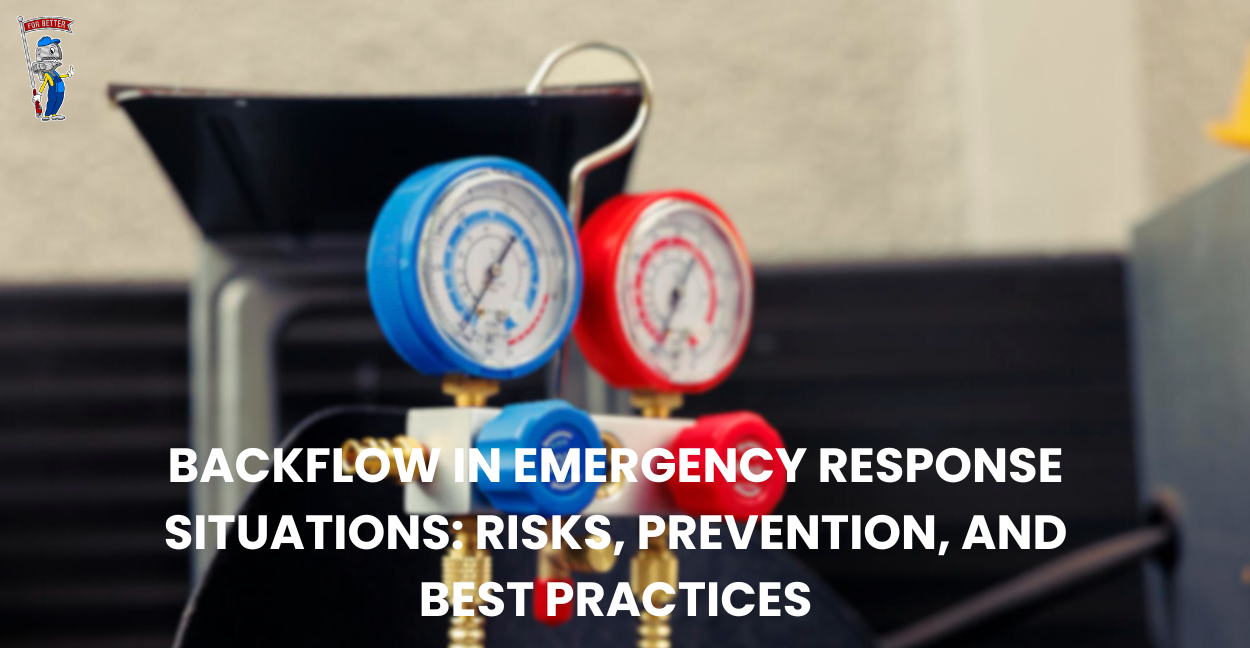In emergency response situations, such as natural disasters, public health crises, or infrastructure failures, the integrity of water supply systems becomes paramount. One critical aspect that demands attention is backflow, a potential hazard that can compromise water quality and pose significant health risks. In this comprehensive guide, we delve into the risks associated with backflow in emergency scenarios, preventive measures, and best practices to ensure water safety.
Risks of Backflow in Emergencies:
The consequences of backflow in emergency response scenarios are profound. Contaminants from sources such as sewage, chemicals, or stagnant water can infiltrate the drinking water supply, posing severe health hazards to the population. Waterborne diseases, chemical exposures, and microbial contamination are among the potential risks associated with backflow incidents during emergencies.
Preventive Measures:
- Backflow Prevention Devices: Installing backflow prevention devices, such as air gaps, check valves, and reduced pressure zone (RPZ) valves, is crucial. These devices act as barriers to prevent the reverse flow of water and contaminants into the potable water supply.
- Regular Inspections and Maintenance: Conducting routine inspections and maintenance of backflow prevention devices is essential to ensure their proper functioning. Certified professionals should inspect and test these devices periodically to identify any potential issues and address them promptly.
- Emergency Response Plans: Integrating backflow prevention measures into emergency response plans is imperative. Establish protocols for shutting off water supply lines, implementing temporary backflow prevention measures, and coordinating with relevant authorities during emergencies.
- Public Awareness and Education: Educating the public about the risks of backflow and the importance of preventive measures is key to fostering a proactive approach. Provide information on identifying potential backflow hazards, reporting incidents, and promoting water safety practices.
Best Practices for Backflow Prevention:
- Risk Assessment: Conduct a thorough risk assessment of water supply systems, identifying vulnerable points and potential sources of contamination.
- Cross-Connection Control: Implement robust cross-connection control programs to prevent the intermingling of potable and non-potable water sources.
- Training and Certification: Ensure that personnel responsible for water supply management and emergency response are trained in backflow prevention techniques and hold relevant certifications.
- Coordination with Authorities: Collaborate with regulatory agencies, public health departments, and water utility providers to develop coordinated strategies for backflow prevention and emergency response.
Backflow poses significant risks in emergency response situations, jeopardizing water safety and public health. By understanding the causes of backflow, implementing preventive measures, and following best practices, we can mitigate these risks and safeguard our water supply systems. Effective communication, collaboration, and proactive planning are essential elements in combating backflow during emergencies and ensuring resilient water infrastructure.
By incorporating these insights into emergency response plans and fostering a culture of awareness and preparedness, we can enhance our ability to respond to crises while protecting the integrity of our water resources.
Backflow and Cross-Connection Control Programs: Ensuring Water Safety
Backflow and cross-connection control programs play a crucial role in maintaining the integrity of water supply systems and safeguarding public health. In this comprehensive guide, we delve into the significance of these programs, their key components, and best practices for effective implementation. By understanding the complexities of backflow and cross-connection control, we can ensure water safety and mitigate potential risks.
Understanding Backflow and Cross-Connections:
Backflow occurs when the flow of water reverses direction, allowing contaminants to enter the potable water supply. Cross-connections, on the other hand, are points in the plumbing system where non-potable water sources may come into contact with drinking water, creating a risk of contamination. These issues can arise from various sources such as irrigation systems, industrial processes, or residential plumbing configurations.
Significance of Cross-Connection Control Programs:
Cross-connection control programs are designed to identify and mitigate potential cross-connections and backflow hazards. These programs are critical in preventing waterborne illnesses, chemical exposures, and other health risks associated with contaminated water. By implementing effective control measures, such as backflow prevention devices and regular inspections, the integrity of the water supply can be preserved.
Key Components of Cross-Connection Control Programs:
- Risk Assessment: Conducting a comprehensive risk assessment to identify potential cross-connections and backflow hazards is the first step. This involves evaluating the plumbing system, identifying vulnerable points, and assessing the likelihood of contamination.
- Backflow Prevention Devices: Installing appropriate backflow prevention devices, such as air gaps, check valves, and reduced pressure zone (RPZ) valves, is crucial in mitigating backflow risks. These devices create physical barriers that prevent the reverse flow of water and contaminants.
- Regular Inspections and Testing: Implementing a schedule for regular inspections and testing of backflow prevention devices is essential. Certified professionals should conduct these assessments to ensure the devices are functioning correctly and meet regulatory standards.
- Cross-Connection Control Policies: Establishing clear policies and procedures for cross-connection control, including documentation, reporting, and corrective actions, is fundamental. Training staff and personnel on these policies is also key to effective implementation.
Best Practices for Effective Cross-Connection Control:
- Education and Awareness: Educating the public, water utility personnel, and relevant stakeholders about cross-connection control and backflow prevention is crucial. Promoting awareness can encourage proactive measures and foster a culture of water safety.
- Regulatory Compliance: Adhering to local regulations, plumbing codes, and industry standards is paramount. Ensure that cross-connection control programs comply with applicable laws and receive necessary approvals and certifications.
- Collaboration and Communication: Foster collaboration between water utility providers, regulatory agencies, plumbers, and building owners to streamline cross-connection control efforts. Effective communication channels can facilitate information sharing and prompt responses to potential risks.
In conclusion, backflow and cross-connection control programs are essential components of water safety initiatives. By implementing comprehensive risk assessments, deploying appropriate backflow prevention devices, and adhering to best practices, we can minimize the risks of contamination and ensure the delivery of clean, safe drinking water to communities. Investing in robust cross-connection control programs not only protects public health but also upholds the integrity of our water supply systems for generations to come.
Contact Backflow Services Done Right
Ready to protect your property from backflow issues? Our team of certified experts is here to help. Contact us today for a comprehensive backflow prevention assessment and tailored solutions that meet your specific needs. Don’t wait until it’s too late – safeguard your water supply with our trusted services. Get in touch now to schedule your consultation and ensure peace of mind for your home or business.



